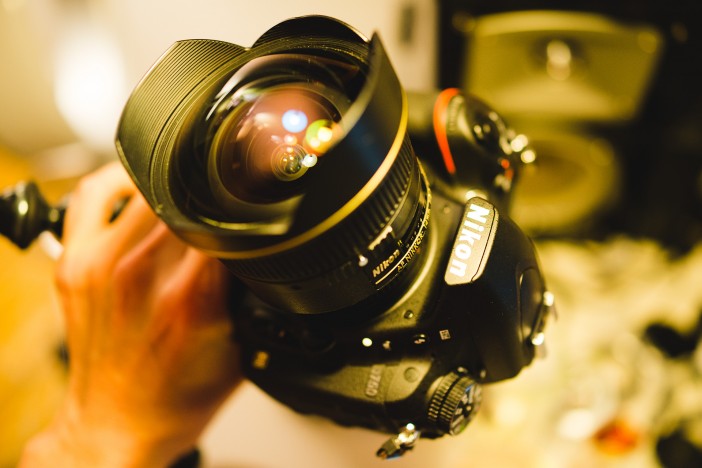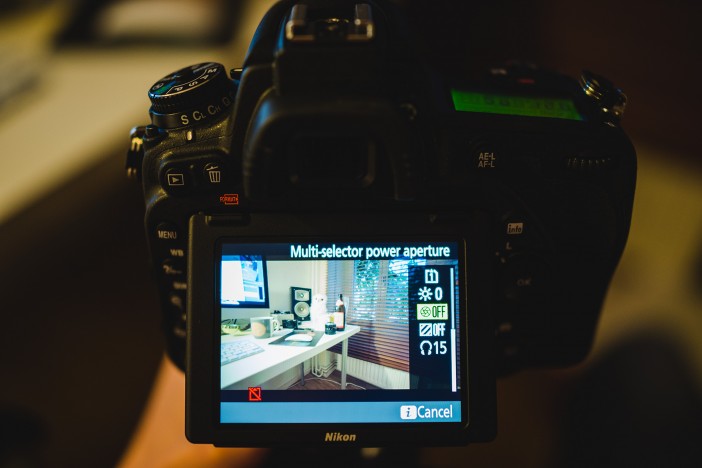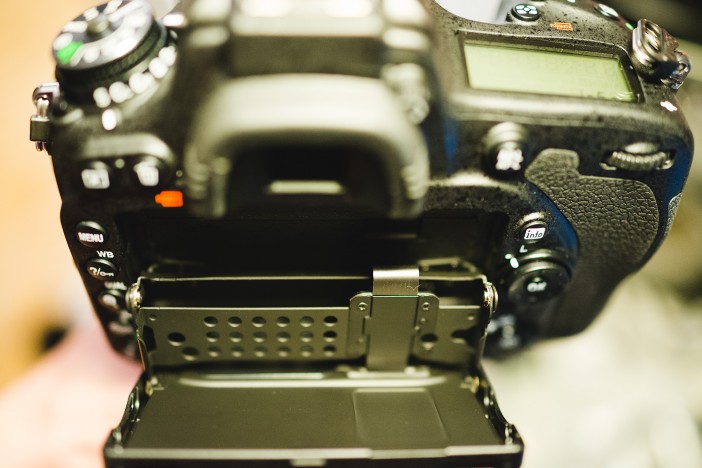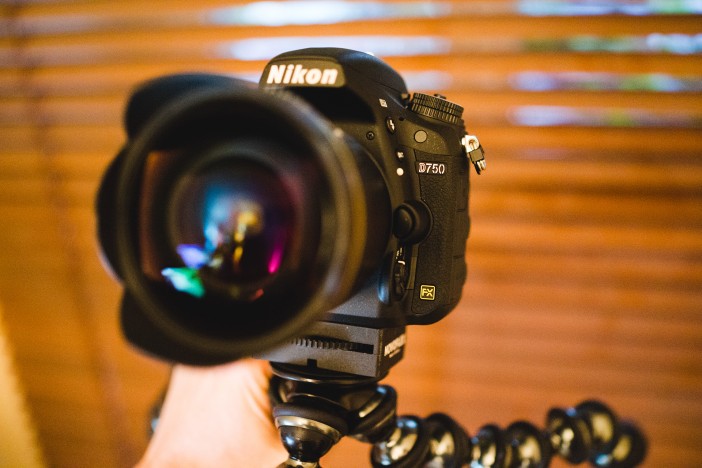Filmmakers have been waiting a long time for a top-performing Nikon full frame FX DSLR for video.
Is the D750 the one we’ve been waiting for?
On the face of it, the Nikon D750 looks less like a D700 successor, more like a very steady evolution of the D610 with flippy screen technology.
Other NASA-like technology include zebras and a flat picture profile. I see the space programme is really paying off for Nikon. At this rate we might even have peaking!
Joking aside, and aside from all those lost years shooting video with moire and aliasing on Nikon cameras, the D750 is actually a surprise. It’s just that a lot of the innovation is hidden from view.
A carbon fibre monocoque chassis for instance, a familiar term to fans of Formula One in that it offers lightness along with extreme rigidity. The D750 has one and it’s ‘gained lightness’ as a result. The 24MP sensor may look like it has the same megapixel count as the D610’s but it is definitely new. The way it scans the image for 1080p is completely different. Gone are moire and aliasing. Detail now looks like true 1080p. Dynamic range with the new image processor and flat picture profile impresses. It’s an even cleaner and more detailed image than the Nikon D5300 for video. It’s extraordinary they did not make more of the image quality gains for video users at the time of the announcement.
No it isn’t 4K as on competing Sony and Panasonic offerings, but that’s in the works according to Nikon. Their official line on 4K is that they think it’s too much for current users. However I am editing 4K on a laptop and I can shoot 4K with a GoPro for under $499, so you can’t get much mass market than that. It’s time for Nikon to expedite their entry to the 4K market, but for now the D750 does 1080p very well.
Nikon colour science
Like Canon, people have long admired Nikon’s colour science. Panasonic and Sony have work to do in this area to catch up.
A recent issue that has come to light (no pun intended) is the clipping of bright blues in Sony A7S S-LOG footage.
https://vimeo.com/107452261
If the D750 can avoid this issue and the other colour balance problems I have experienced with S-LOG on the A7S, as well as giving a flat profile that is easier to grade then Nikon will have an advantage.
So far in my tests, both the D750 and D810 do have an impressive feel to colour across a wide range of shots and it comes alive with only basic post production work.
I’ll be exploring this a lot more in subsequent posts.
Clean
The D610 and D800 both had moire and aliasing, particularly bad in the case of the D610 but that’s nowhere to be seen on the D750. I’ve not seen it once in my live subjects. Only in a lab test or with extremely fine patterns shot at a distance with a wide angle lens does it present itself. That’s the case with practically every other camera including the 5D Mark III, lauded for being clean.
And by the way – the codec on this camera is damned impressive. The word that springs to mind is “smooth”. It has almost no compression noise and colour comes out beautifully. I still haven’t been able to get colour quite where I want it on the A7S with S-LOG and end up having to grade different shots differently which is very time consuming. Within 5 minutes I was able to get gorgeous colour from the D750 merely by applying a different gamma curve in Premiere. It’s a much better codec than Canon have in the 5D Mark III. That suffers from a kind of buzzing ‘mosquito noise’ which is separate to ISO noise and appears in good light at low ISOs even in mid-tones. By comparison the D750’s codec is as clean as a whistle.
Click to expand 1080p frame…
Low light
Nikon’s APS-C cameras had class-leading low light performance even though the sensor was jam packed with 24 million pixels. The D750 spreads out the same number over a much larger full frame sensor as well as introducing the D5300-like ‘special sauce’ of more modern pixel design and less noisy readouts. The result is that the D750 is much less noisy than the D5300 and especially D7100 for video at ISO 1600 and above. It also outperforms the 5D Mark III at high ISOs and delivers a more detailed 1080p image.
At ISO 800 the D750 is so free of noise in video mode that locked down shots with nothing moving in the frame practically look like JPEGs. At ISO 3200 the D750 is as clean as the Sony A7S in the mids and highlights, only a little noisier in the shadows. When you need 12,800 and above though the A7S is the one to pick.
Of course the A7S is still the low light king, but another surprise is that the D750 actually has the better looking 1080/60p in full frame mode. In 24p the A7S is ahead for the very finest detail and of course high ISOs but the two cameras play in the same league which is very interesting.
New “FLT” profile and HDMI
Flat picture profiles on previous Nikon FX bodies like the D610 and D800 I found to be of limited use because the codec had major banding problems especially in the lows These are gone in the D750. It builds on the much better codec Nikon introduced with the D5200 and D5300. The uncompressed HDMI is 4:2:2. This might or might not be interesting on the D750, I’ve yet to try it. I will be hooking up my Atomos Ninja Star to the D750 in part 2 of the review.
Early conclusions
I’m impressed with the ease of which I am able to get accurate colour out of the D750. You don’t need to master S-LOG. The Nikon colour science delivers very well out of the box with the supplied ‘flat’ image profile. I’m also impressed with resolution in 1080/60p, it’s almost as good as the A7S does in 1080/24p – and after a little post – as similar as makes no difference.
At first glance rolling shutter skew is another area the D750 performs admirably as an alternative to the A7S.
The D750 is one of the smallest and lightest full frame Nikon cameras. I prefer it for that reason over the D810, as well as the lower price, articulated screen and better low light performance.
Ergonomically I do find I miss the EVF from the Sony A7S but the Nikon D750 is better built. I find the battery grip creaks on the A7S and overall the D750 just feels more solid, less plasticy. I still have some doubts about the ribbon cable connecting the articulated screen though, it’s too exposed to accidental hits from the top (see below)…
Along with the very nice video quality the D750 has some ergonomic improvements for video users too. We now get a quick menu on the ‘i’ button to toggle video settings in movie mode, like frame rate, picture profile, etc. The quality of the 1:1 focus assist is excellent though sadly there’s no zoomed focus assist available whilst a clip is recording. This is something I really found myself using a lot on the A7S.
Live-view is improved and now thanks to yet more Nikon / NASA technology trickling down from the international space station we can change the aperture in video mode without having to disable live-view!! Amazing I know! I’m also enjoying the exposure simulation option via the “i” menu in live-view mode for stills – so settings changes are reflected in the exposure of the shot on the LCD. Unfortunately Nikon have chosen to store exposure settings separately for movie mode and stills mode, which is a bit bonkers to be honest. If you’re mainly shooting video, have the correct exposure set for the scene and want to reel off a shot with the shutter button, it will take the shutter speed, aperture and ISO you last used through the optical viewfinder. Ridiculous. Who gives feedback like this to a major camera company?!?
As I work with the camera more, the main area of interest for me is colour. If the D750 can produce such easy to grade footage with better colour science than on the Sony, then it’s going to be even more appealing. The A7S does not handle bright neon blue highlights well and the accuracy of reds in S-LOG is a tricky issue too.
The A7S is still the more complete camera for the features it offers. 4K over HDMI will put it in a different league but only with the added bulk of a 4K recorder / external monitor. The A7S has a much more adaptable lens mount too which I can use my Canon, PL, Contax Zeiss and lots of other glass on. Options for the D750 are limited to Nikon’s own lenses and swapping out the mount on Leica R lenses for a Nikon bayonet (albeit easy to do with a screwdriver).
Even for A7S owners like myself the D750 will make a very good B camera, if one has enough lenses to do it justice. I just about do, but I really miss my stabilised Canon lenses. The problem is for Canon lens owners like myself, aside from the very expensive 1D C, Canon are down across the range of DSLRs and mirrorless cameras for performance. They are now a distant 4th on video quality behind Sony, Panasonic and Nikon and a mediocre 3rd behind Sony and Nikon when it comes to stills quality on their APS-C and full frame sensors.
So credit where it’s due to Nikon for finally (albeit lately!) giving us such clean looking video!
More to come!







